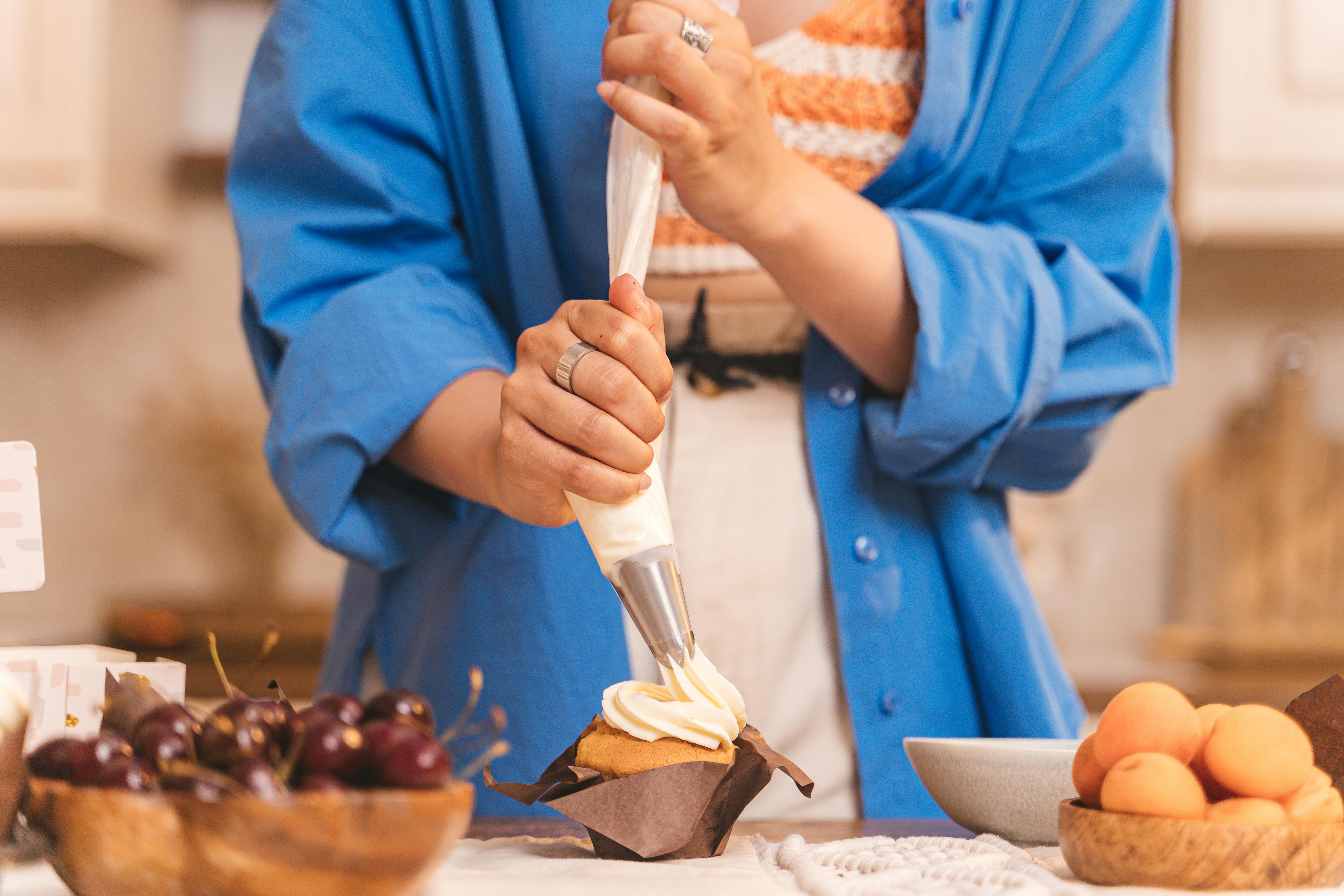Filling your cake layers with a delicious fruit filling can be an incredibly rewarding experience. Not only does it make your cake look and taste great, but it adds a unique texture and flavor to the finished product. In this tutorial, we will walk you through the steps on how to put fruit filling between cake layers. From choosing the right type of fruit to creating a smooth texture, this guide will cover everything you need to know in order to achieve the perfect cake. So let’s get started!To put fruit filling between cake layers, you will need a cake layer, your desired fruit filling, a pastry bag or spoon, and a spatula. Begin by placing one cake layer on a plate or cake stand. Pipe or spoon the fruit filling onto the center of the layer and spread it evenly with the spatula. Then, top with the second cake layer. Gently press down to secure and spread any excess filling around edges. Enjoy!
Preparing the Fruit Filling for Cake Layers
Fruit fillings are a delicious way to add flavor and texture to any cake. Whether you are using fresh fruit, preserves, or canned fruit, there are some simple steps to take when preparing the fruit for your cake layers. First, if you are using fresh fruit, make sure it is ripe and has been washed and dried thoroughly. Then, chop the fruit into small pieces or mash it with a fork depending on the type of fruit you are using. If you are using preserves or canned fruit, simply open the jar or can and spoon out the desired amount of filling. Once all of the fruits have been prepared, combine them in a medium bowl with any desired spices or extracts that you would like to add for flavor. Then stir all of the ingredients together until everything is evenly combined. Finally, spoon the mixture onto each cake layer before proceeding with your recipe instructions.
Fruit fillings can be used in many different types of cakes such as layer cakes, pound cakes, bundt cakes, and cupcakes. They can also be used as toppings for other desserts like pancakes and waffles. With a little bit of creativity, you can create many delicious recipes using this versatile ingredient!
Spreading the Fruit Filling Between Cake Layers
When creating a layered cake, it is important to ensure that the fruit filling is spread evenly between the layers. To do this, first prepare the desired amount of fruit filling according to the recipe instructions. Then, place one of the cake layers on a serving plate. Using an offset spatula or butter knife, spread 1/3 of the filling evenly over the cake layer. Place the second cake layer atop the first and repeat this process with another 1/3 of the filling. Finally, top with a third layer and spread with remaining fruit filling. For a more decorative look, use a pastry bag and tip to pipe stars or other patterns around the edges of the cake. Allow to cool before serving.
Securing the Fruit Filling Between Cake Layers
Securing the fruit filling between cake layers is a critical step in creating beautiful cakes. It requires careful attention to detail and practice to get it right. The goal is to have the cake layers remain securely in place when cutting and serving the cake.
The first step in securing the fruit filling between cake layers is to create an even layer of filling across the entire surface of the cake. This can be done by using a spoon or small spatula to evenly spread the filling over the entire surface of each cake layer. Make sure that all edges are covered and that there are no gaps between layers.
Once the fruit filling is evenly spread, it’s important to use something like a piece of wax paper or parchment paper to press down gently on top of it. This will help ensure that all of the edges are securely adhered to each other. If you need extra help, you can use a rolling pin or your hands to press down gently on top of the wax paper or parchment paper.
After pressing down with wax paper or parchment paper, it’s time to assemble your cake layers together. Start by placing one layer on top of another, making sure they line up correctly and that there are no air bubbles between them. Use a butter knife or offset spatula to press down gently along all edges, making sure they are secure and well-sealed together.
Finally, chill your assembled cake in the refrigerator for at least 30 minutes before frosting and decorating it. This will help ensure that all layers stay securely in place while you work on decorating your masterpiece!
With practice and patience, securing fruit fillings between cake layers can become second nature! Just remember to take your time and be sure not to rush through this important step – it will make all the difference when you serve up your delicious creation!
Using Appropriate Filling
When adding fruit filling between cake layers, it is important to choose the right type of filling for the cake. Fruit fillings are best suited for cakes that are light and airy, such as sponge cakes or angel food cakes. Heavy, dense cakes such as pound cakes or chocolate cakes should be filled with heavier fillings such as custards, mousses, or ganaches.
Preparing the Filling
Before adding the filling to the cake layers, it should be prepared properly. Fruit fillings should be cooked with sugar and thickened with a starch like cornstarch or tapioca starch to help prevent them from seeping through the cake layers. The cooked filling should then be cooled completely before adding it to the cake layers.
Adding the Filling
When adding a fruit filling between cake layers, it is important to use an even layer of filling so that all slices of cake will have an even amount of filling. If using a pastry bag and tip, pipe a spiral pattern onto each layer before stacking them together. Using this method will ensure that each layer has an even amount of filling throughout. If using a spoon or spatula, spread an even layer over each layer before stacking them together.
Stacking and Refrigerating
Once all of the cake layers have been filled with fruit filling, stack them carefully so that they stay in place while baking and cooling. It is also important to refrigerate the finished cake for at least one hour before serving in order to give the fruit filling time to set up properly. This will ensure that each slice has an even amount of fruit filling throughout when served.

What Kind of Fruit Filling Can You Use?
Filling your pastry with fruit is a delicious way to add flavor and texture. The best type of fruit filling depends on the recipe you’re making. Apples, pears, and cherries are popular fruits used to make pies and cobblers. For a tart, you can use lemon or lime curd, or even a combination of different fruits like strawberries and blueberries. If you’re making something like a strudel, you can use a mixture of apples, raisins, cinnamon, and sugar. If you’re looking for something more exotic, try using tropical fruits like banana, mango, papaya, or pineapple. Whichever fruit you choose for your filling, it should be ripe and flavorful so that it adds sweetness to the dish. When using fresh fruit in your filling, it’s important to cook and thicken it first so that it doesn’t leak out during baking.
When baking pies or tarts with fresh fruit fillings, it’s best to pre-cook the filling before adding it to the crust. This helps reduce moisture and prevent sogginess. Pre-cooking also helps enhance the flavor of the fruits by allowing them to release their natural juices and sugars into the filling mixture. You can pre-cook most fillings on the stovetop over medium heat until thickened or in a microwave oven for just a few minutes.
If you’re short on time or don’t feel like pre-cooking your filling, there are other options available as well. Canned pie fillings are widely available in stores and come in many different flavors such as cherry, apple-cinnamon, blueberry, peach-apricot, raspberry-blackberry blend etc. Canned fruit fillings are already cooked so they don’t require any additional preparation before adding them to your pastry crusts.
No matter which type of fruit filling you decide to use for your recipe—fresh or canned—you can always add extra flavor by folding in nuts such as pecans or walnuts into the mix before baking!
Creative Ways to Use Fruit Fillings for Cakes
Fruit fillings are a great way to add variety and flavor to cakes. Whether you’re looking for a traditional fruit-based cake or something more creative, there are many ways to incorporate fruit into your cake designs. From adding slices of fresh fruit as a topping, to incorporating purees and jams into the batter, the possibilities are endless. Here are some creative ways to use fruit fillings for cakes.
One creative way to use fruit fillings in cakes is to layer them between layers of cake. This adds texture and flavor as well as visual interest. Start with a light layer of cake batter on the bottom, then spread a thin layer of your favorite jam or puree over it. Top it off with more cake batter and bake it until done. You can also try adding other ingredients such as nuts or chocolate chips for added flavor and texture.
Another great way to incorporate fruit into cakes is by making a glaze or frosting with pureed fruit. Use fresh or frozen fruit to make a thick puree, then mix it with powdered sugar until you achieve the desired consistency. You can then spread this over the top of your cake for an elegant and flavorful finish.
If you’re looking for an even simpler way to add fruity flavors to your cakes, consider using canned pie filling instead of making your own jam or puree from scratch. Simply spread the pie filling over the top of your cooled cake before adding frosting or glaze for an easy but delicious touch.
Finally, if you’re looking for something really unique, why not try making a “fruitcake”? Instead of baking layers of cake and filling, combine all the ingredients together in one pan before baking. This will create one large “cake” that is filled with fresh fruits like blueberries, raspberries, cherries, apples, etc., giving you an amazing combination of flavors all in one bite!
No matter which method you choose, adding fresh fruits in cakes is always sure to be a hit with friends and family alike! With so many different ways to use fruit fillings for cakes, you can easily come up with creative recipes that will be sure to please everyone’s taste buds!
How Much Fruit Filling Do You Need?
When it comes to baking a delicious dessert, one of the most important ingredients is the fruit filling. Whether you are making a tart, pie, or cake, having the right amount of fruit filling is essential for achieving maximum flavor and texture in your finished product. The amount of fruit filling you need will depend on the size and shape of your dessert as well as the amount of other ingredients used.
For pies, tarts, and cakes with a single crust or layer, you will usually need about two to three cups of fruit filling per nine-inch dish. If you are making an extra-large dessert, such as a 10-inch or 12-inch dish, then you may need up to four cups of fruit filling. For desserts with multiple layers or crusts, such as an apple pie or tartlet with a lattice top, then you may need up to five cups of fruit filling for a nine-inch dish.
If you are making individual desserts such as cupcakes or mini-tarts, then you will only need about one tablespoon of fruit filling per serving. For larger individual desserts such as hand pies or turnovers, then you may need up to two tablespoons per serving.
Finally, if you are making a layered cake with multiple layers and frosting in between each layer, then each layer should have about one cup of fruit filling between them. This will ensure that each layer has enough moisture and flavor without being overwhelmed by too much sweetness.
In conclusion, when it comes to baking desserts with fruit fillings there are no hard and fast rules for how much to use; it all depends on the size and shape of your dessert and the number of other ingredients used in the recipe. However, these guidelines should provide some general guidance on how much fruit filling is needed for various types of desserts.

Conclusion
Adding fruit filling between cake layers is a great way to add flavor and texture to your cake. It also helps create a beautiful presentation that your guests will admire. There are many different types of fruit fillings you can use, from jams and preserves to fresh fruits for a more contemporary look. You can also make your own homemade fillings if desired. The key is to start with a good quality cake recipe and then add in the filling of your choice for the perfect finishing touch.
No matter what type of cake you are making, adding a delicious fruit filling between the layers can take it from ordinary to extraordinary! With just a few simple steps, you can easily transform an ordinary cake into an impressive dessert that everyone will love.



